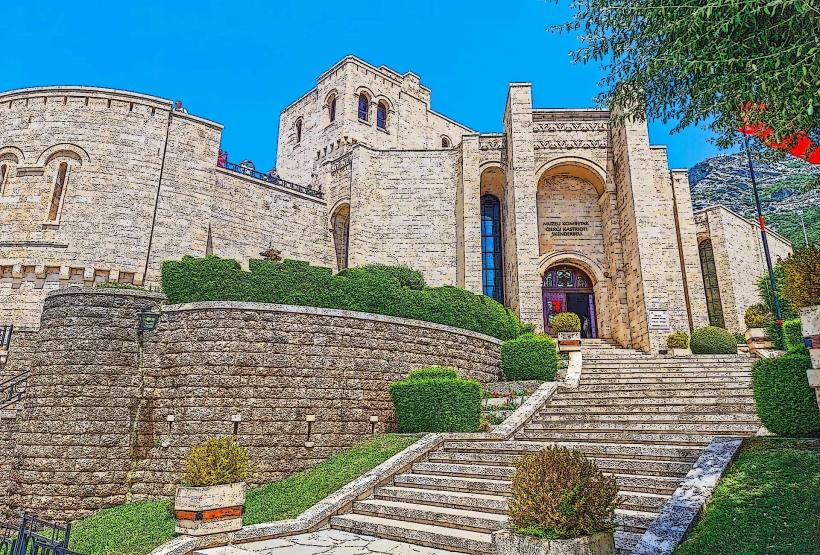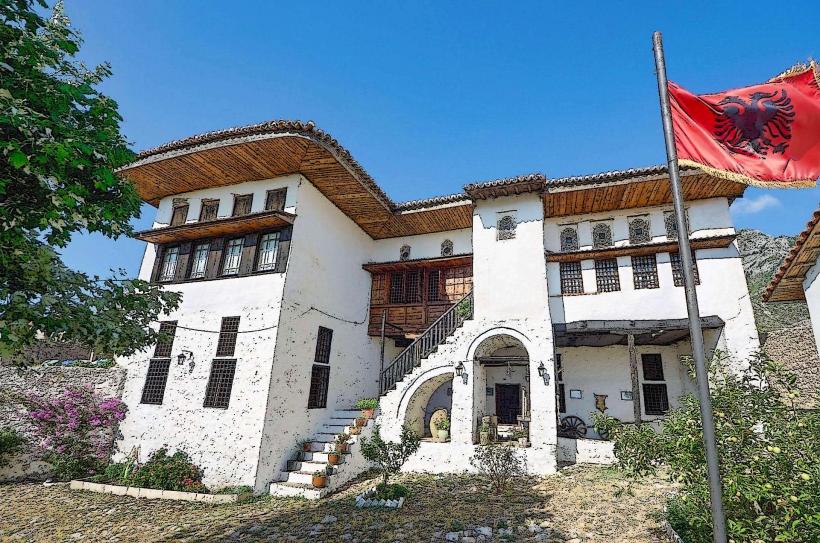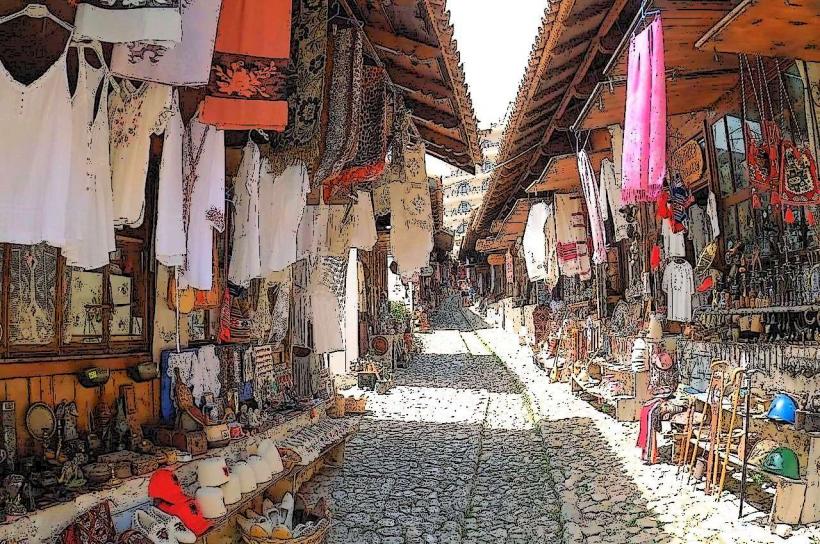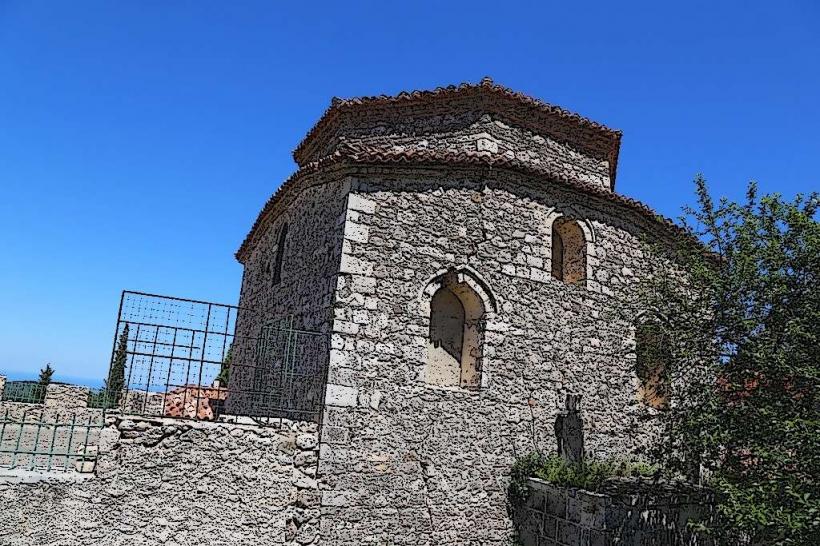Information
Landmark: Krujë CastleCity: Kruje
Country: Albania
Continent: Europe
Krujë Castle (Kalaja e Krujës) is one of Albania's most significant historical and cultural landmarks. Located in the town of Krujë, about 20 kilometers (12 miles) north of Tirana, the castle is renowned for its role in Albanian history, particularly as the stronghold of the national hero Gjergj Kastrioti, better known as Skanderbeg. The castle's strategic position, perched atop a steep hill, offers stunning views of the surrounding valley and the Adriatic Sea.
History and Significance
Skanderbeg and the Ottoman Resistance:
- Krujë Castle is most famous for being the base of Skanderbeg, the Albanian national hero who led a heroic resistance against the Ottoman Empire in the 15th century. The castle was his main fortress and a key site in his long campaign to protect Albanian lands from Ottoman conquest.
- Skanderbeg's resistance lasted for over two decades (1443–1468), during which time the castle and the town of Krujë served as the center of Albanian resistance.
- In 1468, after Skanderbeg's death, the castle eventually fell to the Ottomans, but it remains an enduring symbol of Albanian courage and nationalism.
Fortification and Design:
- The castle itself is a complex of fortified walls, watchtowers, and gates, designed for military defense. The walls are constructed from local stone, and the castle's location on a hill made it a formidable stronghold.
- The castle includes several defensive structures, including a large central tower and a system of gates. There are also ruins of old buildings and a bastion which was used to defend against siege attacks.
Historical Importance:
- Krujë Castle played an essential role in the fight for Albanian independence. It was the last major stronghold to resist Ottoman rule, and its capture marked the end of Skanderbeg's resistance.
- The castle is also important in the history of Albania's independence from the Ottoman Empire. The legacy of Skanderbeg and the castle as a symbol of resistance is still a major part of Albanian culture and identity.
Castle Museum and Exhibits
The Skanderbeg Museum:
- Inside Krujë Castle, visitors can explore the Skanderbeg Museum, which is dedicated to the life and legacy of Gjergj Kastrioti (Skanderbeg). The museum features a collection of historical artifacts, paintings, and weapons related to Skanderbeg’s military campaigns and his fight against the Ottomans.
- The museum is housed in the former Royal Palace of the Kastrioti family, offering visitors a glimpse into the medieval history of Albania. Exhibits include armor, weapons, and documents that shed light on Skanderbeg's life and his leadership in the resistance.
Ethnological Museum:
- The Ethnological Museum is another important exhibit housed within the castle complex. It focuses on the traditional culture, costumes, and crafts of the region, providing visitors with insight into the daily life of Albanians during the medieval period.
Artifacts and Historical Objects:
- Various other objects, such as ancient coins, pottery, and relics from the castle’s long history, can be found throughout the museum. These artifacts highlight the rich cultural heritage of the region.
Castle Features and Layout
Main Gate:
- The castle has a main gate, which is protected by a fortified passage and iron doors. This gate was once a primary defense mechanism against invaders and is still intact today.
Watchtowers and Bastions:
- Krujë Castle has several watchtowers and bastions, offering excellent panoramic views of the surrounding countryside and mountains. These towers were vital for spotting approaching enemies and defending the castle from attacks.
Church of St. George:
- Inside the castle complex is the Church of St. George, a small Orthodox Christian church that dates back to the medieval period. The church adds to the historical and religious significance of the castle, offering visitors a peaceful spot to reflect.
Panoramic Views:
- The castle’s elevated position provides sweeping views of the town of Krujë, the surrounding mountains, and the Adriatic Sea in the distance. Visitors can take in the natural beauty of the area while imagining the strategic importance of the castle during Skanderbeg’s time.
Krujë Town and Surroundings
Krujë Bazaar:
- At the base of Krujë Castle is the Krujë Bazaar, a traditional market where visitors can purchase handmade crafts, local Albanian souvenirs, woven textiles, ceramics, and jewelry. The bazaar is a great place to experience the local culture and traditions.
- The market is housed in a series of Ottoman-era buildings, which have been preserved and offer an authentic experience of Albanian craftsmanship.
Krujë Museum:
- In addition to the castle’s museum, the town of Krujë is home to the Krujë Museum, which explores the broader history of the town and its role in Albanian history. The museum includes exhibits on the Ottoman period, the National Renaissance, and the struggle for independence.
Krujë's Cultural Significance:
- Krujë is often referred to as the “city of the Albanian Renaissance” due to its historical importance in the national movement for independence. It was the home of several prominent Albanian intellectuals and national leaders who played significant roles in the country's cultural and political development.
Visiting Krujë Castle
- Opening Hours: Krujë Castle and its museums are generally open to visitors every day, with specific hours from 9 AM to 7 PM (depending on the season). It’s best to check in advance for any changes or closures.
- Entrance Fees: There is a modest entrance fee to visit the castle and museums. The fee helps support the preservation of the site and its historical exhibits.
- Guided Tours: Visitors can take guided tours to learn more about the castle’s history, its strategic significance, and the life of Skanderbeg. These tours are available in several languages, including English.
Best Time to Visit
- The best time to visit Krujë Castle is during the spring (April to June) and fall (September to October), when the weather is mild, and the crowds are fewer. Summer months (July to August) can be busy, especially during peak tourist season, but the views and historical experience are still worth it.
- The castle is a great destination year-round, as it offers both indoor and outdoor attractions, including the museum and the chance to explore the surrounding area.
Conclusion
Krujë Castle is one of Albania's most important historical sites, offering visitors a chance to step back in time and learn about the country's medieval history, Skanderbeg's resistance against the Ottomans, and the broader Albanian national identity. The combination of stunning views, historical significance, and cultural exhibits makes Krujë Castle a must-visit destination for anyone exploring Albania’s rich heritage.





